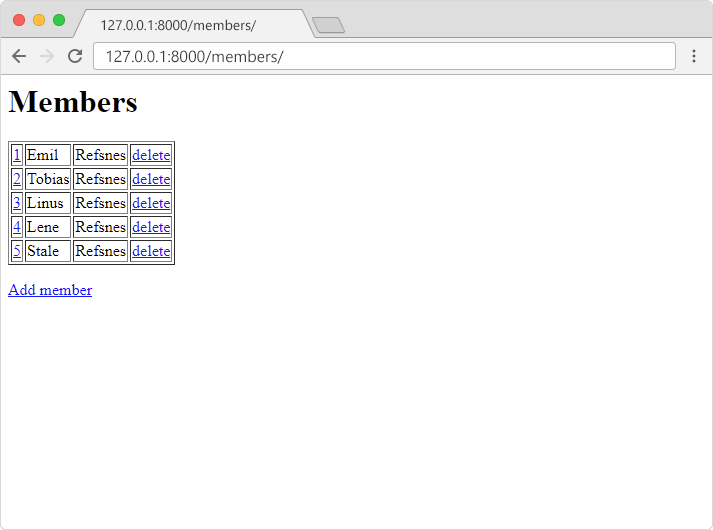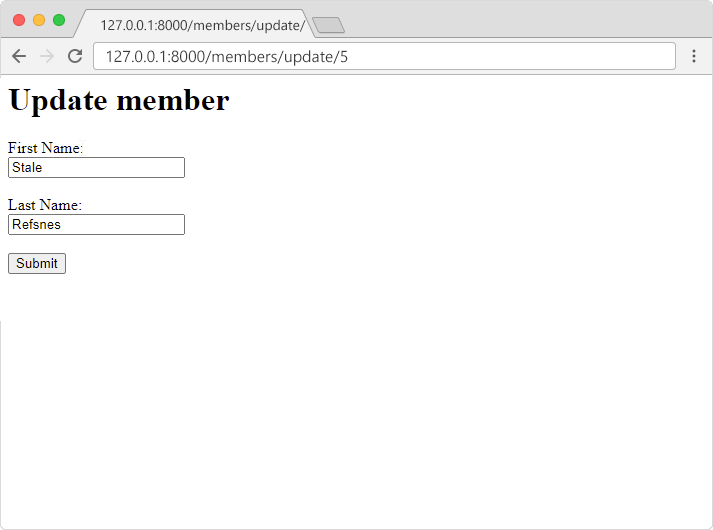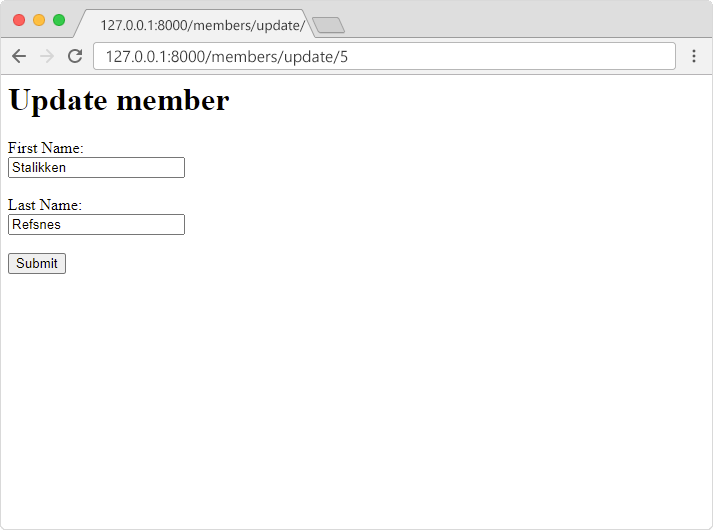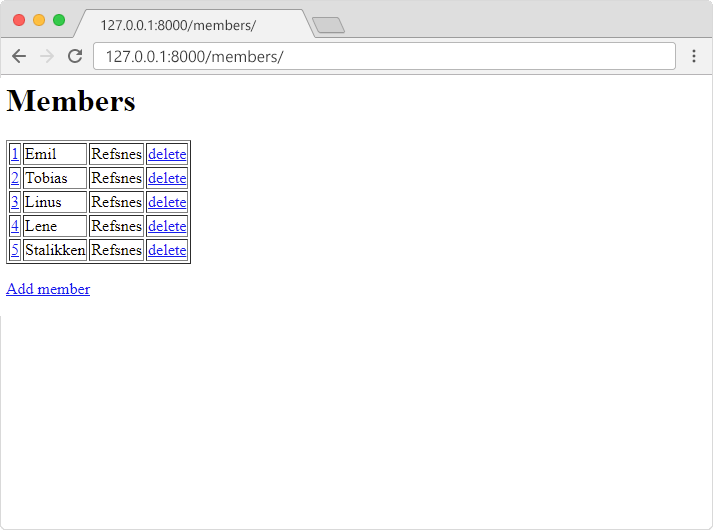Django Update Record
Updating Records
To update a record, we need the ID of the record, and we need a template with an interface that let us change the values.
First we need to make some changes in the index.html template.
Modify Template
Start by adding a link for each member in the table:
members/templates/index.html:
<h1>Members</h1>
<table border="1">
{% for x in mymembers %}
<tr>
<td><a href="update/{{ x.id }}">{{ x.id }}</a></td>
<td>{{ x.firstname }}</td>
<td>{{ x.lastname }}</td>
<td><a href="delete/{{ x.id }}">delete</a>
</tr>
{% endfor %}
</table>
<p>
<a href="add/">Add member</a>
</p>The link goes to a view called update with
the ID of the current member.
The result will look like this:

View
Next, add the update view in the members/views.py
file:
members/views.py:
from django.http import HttpResponse, HttpResponseRedirect
from django.template import loader
from django.urls import reverse
from .models import Member
def index(request):
mymembers = Member.objects.all().values()
template = loader.get_template('index.html')
context = {
'mymembers': mymembers
}
return HttpResponse(template.render(context, request))
def add(request):
template = loader.get_template('add.html')
return HttpResponse(template.render({}, request))
def addrecord(request):
first = request.POST['first']
last = request.POST['last']
member = Members(firstname=first, lastname=last)
member.save()
return HttpResponseRedirect(reverse('index'))
def delete(request, id):
member = Member.objects.get(id=id)
member.delete()
return HttpResponseRedirect(reverse('index'))
def update(request, id):
mymember = Member.objects.get(id=id)
template = loader.get_template('update.html')
context = {
'mymember': mymember,
}
return HttpResponse(template.render(context, request))The update view does the following:
- Gets the
idas an argument. - Uses the
idto locate the correct record in the Members table. - loads a template called
update.html. - Creates an object containing the member.
- Sends the object to the template.
- Outputs the HTML that is rendered by the template.
New Template
Add a new template in the templates folder,
named update.html:
members/templates/update.html:
<h1>Update member</h1>
<form action="updaterecord/{{ mymember.id }}" method="post">
{% csrf_token %}
First Name:<br>
<input name="first" value="{{ mymember.firstname }}">
<br><br>
Last Name:<br>
<input name="last" value="{{ mymember.lastname }}">
<br><br>
<input type="submit" value="Submit">
</form>The template contains an HTML form with the values from the selected member.
Note: Django requires this line in the form:
{% csrf_token %}
to handle Cross Site Request Forgeries in forms where the method is POST.
URLs
Add a path() function in the members/urls.py file, that points the url
127.0.0.1:8000/members/update/ to the right location,
with the ID as a parameter:
members/urls.py:
from django.urls import path
from . import views
urlpatterns = [
path('', views.index, name='index'),
path('add/', views.add, name='add'),
path('add/addrecord/', views.addrecord, name='addrecord'),
path('delete/<int:id>', views.delete, name='delete'),
path('update/<int:id>', views.update, name='update'),
]In the browser, click the ID of the member you want to change and the result should look like this:

What Happens on Submit?
Did you notice the action attribute in the HTML form?
The action attribute specifies where to send the form data, in this case the form data
will be sent to:updaterecord/{{ mymember.id }},
so we must add a path() function in the members/urls.py file that points to
the right view:
members/urls.py:
from django.urls import path
from . import views
urlpatterns = [
path('', views.index, name='index'),
path('add/', views.add, name='add'),
path('add/addrecord/', views.addrecord, name='addrecord'),
path('delete/<int:id>', views.delete, name='delete'),
path('update/<int:id>', views.update, name='update'),
path('update/updaterecord/<int:id>', views.updaterecord, name='updaterecord'),
]Code for Updating Records
So far we have made the user interface, and we point the URL to the view
called updaterecord, but we have not made the
view yet.
Make sure you add the updaterecord view in the in the members/views.py file:
members/views.py:
from django.http import HttpResponse, HttpResponseRedirect
from django.template import loader
from django.urls import reverse
from .models import Member
def index(request):
mymembers = Member.objects.all().values()
template = loader.get_template('index.html')
context = {
'mymembers': mymembers,
}
return HttpResponse(template.render(context, request))
def add(request):
template = loader.get_template('add.html')
return HttpResponse(template.render({}, request))
def addrecord(request):
x = request.POST['first']
y = request.POST['last']
member = Members(firstname=x, lastname=y)
member.save()
return HttpResponseRedirect(reverse('index'))
def delete(request, id):
member = Member.objects.get(id=id)
member.delete()
return HttpResponseRedirect(reverse('index'))
def update(request, id):
mymember = Member.objects.get(id=id)
template = loader.get_template('update.html')
context = {
'mymember': mymember,
}
return HttpResponse(template.render(context, request))
def updaterecord(request, id):
first = request.POST['first']
last = request.POST['last']
member = Member.objects.get(id=id)
member.firstname = first
member.lastname = last
member.save()
return HttpResponseRedirect(reverse('index'))The updaterecord function will update the
record in the members table with the selected ID.
Try to update a record and see how it works:

If you press the submit button, the members table should have been updated:


